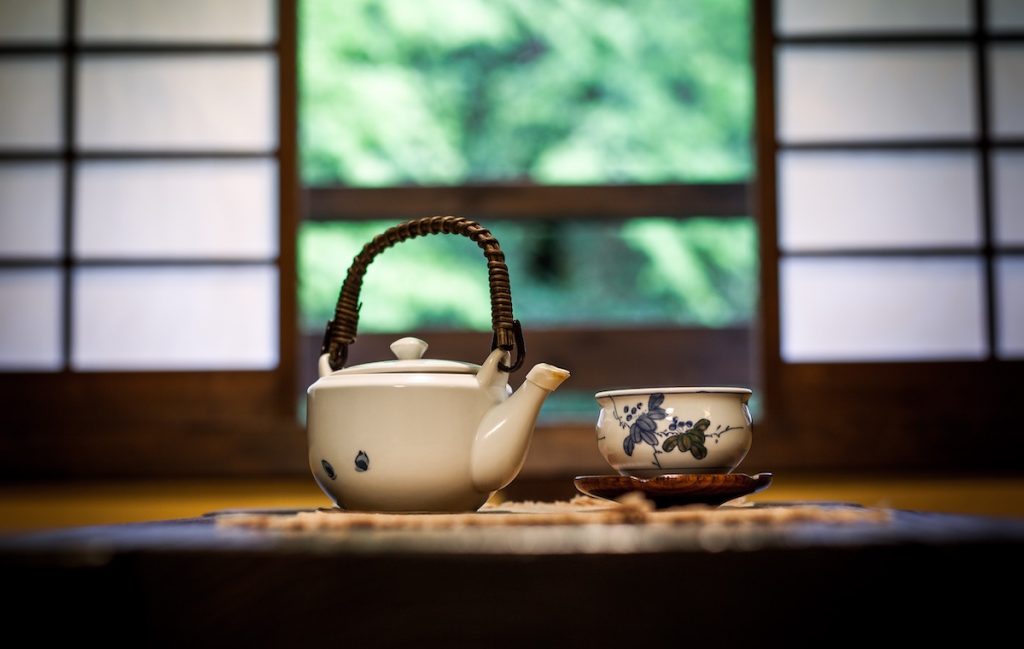Best Japanese Tea
Did you know that there are about 20 different types of Japanese tea? From steamed sencha to ground matcha, there are plenty of different kinds of teas for you to dive into. But what tea is the best Japanese tea?
If you’ve been looking into the top Japanese teas, we’re here to help. Read on for some of the best teas you can get out of Japan.

The Best Japanese Tea
Now that we know a bit more about the different kinds of tea, let’s dive into some options that one could consider to be the best Japanese tea. These four teas are great options, and if you’ve been looking to pick a winner, we’d strongly suggest that you look into these four.
1. Tea Mind Body’s Organic Matcha Green Tea
Our favorite tea is Tea Mind Body’s green matcha option. As the name suggests, this tea is among the highest qualities possible—however, it’s worth saying that Tea Mind Body doesn’t declare if it’s culinary or ceremonial grade. Finely stone ground, the quality is high regardless of the category, and you should expect it to melt away in your cup with ease.
It’s also worth mentioning that this tea is Japanese style and matches matcha perfectly, but it is technically not a Japanese tea. Tea Mind Body sources this tea from China and refer to it as Chinese matcha, but the preparation is the same. Made from fresh green tea leaves and stone ground, it’s suggested that you use a bamboo whisk to get the trademark froth.
Whether you prefer it hot or cold, this tea can easily match your desires. A deep, dark, grassy green, the tea is best enjoyed hot if you want to release the antioxidants. However, you should steep it hot either way and ice it afterward, as cold water won’t dissolve the matcha as well.
Tea Mind Body also sells this tea relatively in bulk, with the smaller option having enough to make about 60 cups of tea. If you drink a cup of day as many health experts suggest, this is a two-month supply! Despite not technically being Japanese, it’s a high-quality Japanese-style tea that won’t disappoint you.
2. FGO Organic Sencha Loose Leaf Tea
Beginning with the sencha, we have the FGO organic sencha loose leaf tea. But first, what’s the benefit of having loose leaf tea? Isn’t it better to have the tea already set in a bag so that you can drop it into your cup and go?
While bagged tea is convenient, that doesn’t make loose leaf tea worse. Having the tea out of a bag makes it so that you can add as much as you prefer in case you want your tea weaker or stronger. Free-steeping it with something like a french press or a teapot is also easier if you don’t like bags. Bagless tea also cuts down on waste from tea bags.
Following the standard, though, this bag comes with enough to make about 50 cups of tea! You also have the option of re-steeping some tea if you’d like, though it certainly won’t come out as strong. That means that this bag can last you for a good while, so you don’t have to go and grab more tea every week.
Certified USDA Organic by the CCOF (California Certified Organic Farmers), this four-ounce pack is a high-quality tea that can last you for much longer than many other options will. So whether you want to customize your tea or just avoid bags, this is a great way to get into sencha teas.
Additionally, FGO doesn’t want you to commit to something you don’t like. FGO’s “love it or buy it” motto comes into effect here by making it easy to refund your order. If you don’t like this sencha and want to go for something else, you can simply contact FGO and obtain a refund.
That said, as far as teas go, FGO doesn’t charge as much as many brands. Organic brands especially have a habit of massively raising their prices to take advantage of more health-conscious trends. So as far as affordable, high-quality, organic green teas go, FGO’s option makes a strong case for itself as the best Japanese tea.
3. Jade Leaf Organic Matcha Green Tea Powder
Moving away from sencha teas, we have our first of two matcha teas. The Jade Leaf Organic Matcha Green Tea Powder says everything there is to say about what to expect in the bag. In terms of grade, this tea is culinary-grade matcha, which means that it’s lower quality than ceremonial teas.
However, don’t let terms like “lower quality” or “culinary” turn you away from thinking this is an amazing tea. Culinary-grade matcha is dominantly used in cooking and is a versatile ingredient. It still makes a stunningly delicious cup of tea but is a quality that many consider below the requirements for ceremonial tea uses.
These shade-grown tea leaves are grown without any pesticides or harmful fertilizers. Sourced from Uji and Kagoshima from partner family farms, Jade Leaf’s tea is from one of the few Japanese tea farms certified as organic.
As a healthy superfood, this matcha is thoroughly packed with antioxidants and vitamins to help give you energy. Given that it’s powdered tea, you won’t have any bags, as the tea will dissolve directly into your cup.
Given its culinary quality, it isn’t strictly necessary to use traditional matcha equipment to make this tea. While a bamboo whisk and stirring cup might help bring out the flavor a bit, you’ll be fine stirring it into hot water to help release the flavors.
4. Yamasan Certified Organic Sencha Leaves
Moving to a second organic sencha, we have the Yamasan Certified Organic Sencha. But what makes one sencha better than the other if they’re the same type of tea?
Yamasan’s organic green tea is blended with the first and second harvest teas. The first harvest of a tea—also referred to as the “flush harvest”—is the first harvest of the year. These teas are usually much higher quality, as the tea is rich in vitamins and minerals from surviving the winter. Mixing the two helps keep the cost lower and the quality higher.
Yamasan also insists that their tea experts check the quality of the tea leaves every year. They also make sure that there are no mixed varieties within the leaves so that you’re always getting pure sencha tea. From planting to harvest, Yamasan does everything they can to ensure their sencha is of the highest quality possible.
Lightly steamed, this sencha is easy to brew and easier to drink. Yamasan suggests brewing their tea both in the traditional hot and cold brews. Hot tea will help release the antioxidants and vitamins that make green tea popular for health reasons. Cold brewing gives a richer, deeper flavor and makes an especially refreshing beverage for hot days.
Whichever way you pick, this tea is a great way to dive into the world of sencha. With easy brewing techniques and fantastic quality, tea novices and experts alike can find something wonderful about Yamasan’s sencha leaves.
Just as with FGO, Yamasan offers a money-back guarantee in case you’re dissatisfied. That said, in your quest to find the best Japanese tea, it’s highly unlikely that either of these two sencha teas will disappoint you.
Types of Teas
Before we dive too far into the best tea, we should know what kind of teas might make it onto the list. As a note, not every tea mentioned here will make it onto our list of the best Japanese teas. That said, they’re still highly-popular choices that you should know about to make your own decision!
Sencha
Sencha is a popular type of Japanese ryokucha tea. One prepares ryokucha by infusing the entire leaf in hot water to steep the tea. Many other teas, such as matcha or gunpowder green teas, don’t do this. As a result, Sencha is often the most popular tea in Japan.
Sencha is favorable for being high in antioxidants and vitamin C. It’s also known for its energy-boosting properties due to this. Many also will add sencha teas to their diets for their ability to help burn fat. Sencha is also favorable as a beginner tea as it’s steeped at a similar temperature and duration to many other teas.
Fukamushicha
Fukamushicha translates literally to “deep steamed tea,” which alludes to how the tea is made. Though most teas are steamed for about half a minute to 90 seconds, fukamushicha is steamed for around two minutes. The purpose of this is to make the tea dissolve into smaller pieces for a richer, greener color of tea.
As a result, this tea doesn’t need to steep for as long as others. Since the leaves are already mostly dissolved, you can also steep the tea at a lower temperature. The leaves will steep much quicker, but the change in time and temperature makes it easy to make a bad cup of tea, so most beginners may avoid fukamushicha.
Herbal
Herbal teas are a massive category. These teas aren’t exclusively Japanese. Some consider herbal teas “real tea” since it sometimes isn’t derived from the Camellia sinensis plant. Instead, herbal teas might consist of barks, fruits, and other edible parts of non-tea plants.
Still, many Japanese herbal teas are popular. Shincha, buckwheat tea, soybean teas, biwa, soba, and bitter melon tea are great examples. These teas have different effects depending on the plant they’re derived from.
Green
Green tea, like herbal tea, is a broad category of teas. Beginners to tea will sometimes think that a type of tea—green, black, white, etc.—is a single tea. However, if you go to the store and ask for green tea, you’ll have dozens of options rather than one single tea.
Green tea isn’t strictly Japanese and is culturally prevalent in many nations, such as China. In Japan, green tea is prevalent culinarily, culturally, and in hospitality. For example, it’s common for a host to give green tea to a visitor.
Sencha is the most popular type of green tea in Japan, though there are plenty of others. Matcha is another well-known type of green tea, though it has a different place culturally and ceremonially. Outside of Japan, matcha is one of the most popular green tea types among those big fans of Japanese culture.
Matcha
The final tea to mention is matcha, which we’ve touched on above. To dive deeper, matcha is a type of green tea made into a powder from green tea leaves. The leaves are dried and then ground into a fine powder, with the quality of the tea directly related to how finely ground the tea is. Lower quality matcha is often coarser and harder to use.
The powder is typically placed in a cup and stirred vigorously with a bamboo whisk. Doing so causes the tea to dissolve and often creates a small froth. Matcha has many ceremonial applications and is also favored for a bitter taste and a vibrant, verdant appearance. In addition, it has many of the same health benefits as other green teas like sencha.
Because of the differing qualities and ceremonial uses, matcha comes in two grades—ceremonial and culinary. Ceremonial tea’s preparation is deeply rooted in tradition and produces a more expensive, higher-quality tea. On the other hand, culinary matcha is often mass-produced and is a cheaper, lower-quality tea.
Pick a Brew
While these four teas are a fantastic option for the best Japanese tea available, plenty of others may win your heart over.
Whether you go for a sencha, matcha, herbal, or something else entirely, the world of tea is sure to have something you’ll love. So try these brews and many more to find the best Japanese tea for you.
If you have more questions about steeping tea and the best Japanese teas, feel free to contact us or browse our site to learn more.
